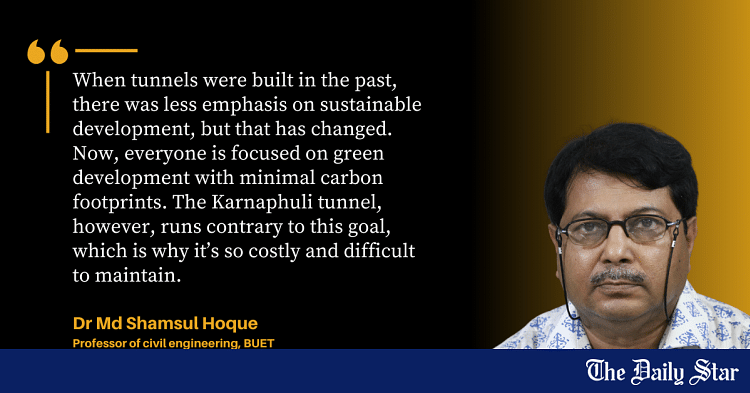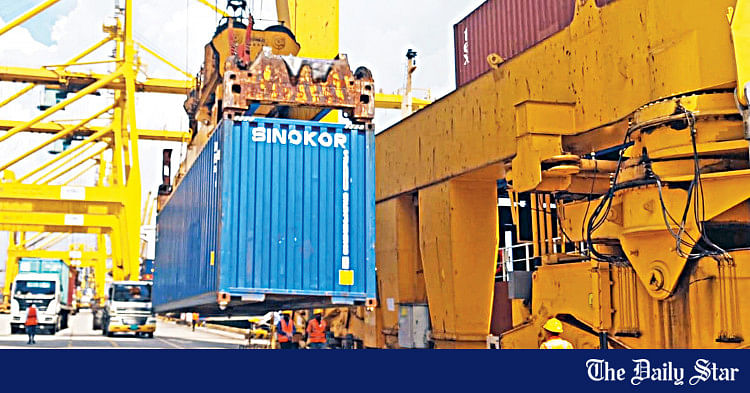Saif
Senior Member
- Jan 24, 2024
- 12,694
- 7,061
- Origin

- Residence

- Axis Group

- Copy to clipboard
- Thread starter
- #49
Govt to review Bay Terminal project
The interim government will review the Bay Terminal project, the biggest expansion project in the Chattogram port’s history.
Govt to review Bay Terminal project
Shipping ministry calls high-powered meeting on Sunday
The interim government will review the Bay Terminal project, the biggest expansion project in the Chattogram port's history.
The megaproject, approved by the recently deposed Awami League government, has seen little progress since former prime minister Sheikh Hasina unveiled the masterplan on November 14 last year.
Other than some preliminary digging to prepare the land, there has been no physical progress so far.
Now, the new government wants to thoroughly evaluate the necessity of such a large project, for which global port operators have already expressed their willingness to invest over $8 billion, according to sources.
The interim government wants to evaluate the necessity of such a large project, for which global port operators expressed willingness to invest over $8 billion
The shipping ministry has called a high-powered meeting on November 10 in this regard, inviting senior officials of different government agencies and representatives of development partners for detailed discussions.
It also asked Chittagong Port Authority (CPA) to present a detailed presentation on the project and its progress so far.
Brig Gen (retd) Dr M Sakhawat Hussain, adviser to the shipping ministry, will chair the meeting.
Senior officials of the shipping ministry, Public Private Partnership Authority (PPPA) and officials as well as the chairman of the CPA will be present.
Representatives of interested investors, including the World Bank, will also attend the meeting.
Contacted, CPA Secretary Md Omar Faruk confirmed that the ministry called the meeting to discuss the project.
During a visit to the port last month, the shipping adviser inspected different project sites, including the site for the Bay Terminal. He was also briefed about the projects by port officials during a meeting.
Speaking to journalists during the visit, the adviser said he saw no problem with the project but added that he would need to discuss it further.
He also said he would ask the CPA officials to present a detailed presentation on the project at the ministry later.
A senior CPA official said the move was part of the interim government's ongoing evaluation of different megaprojects that were approved by the previous regime.
So, the ministry wants to evaluate the project in detail before taking the next step, the official added.
The previous government approved establishing the Bay Terminal, comprising four terminals, on around 2,500 acres of land at Patenga on the coast of the Bay of Bengal.
It is expected that once the project is implemented, vessels with a draft of up to 12 metres and a length of 280 metres will be able to berth there.
Currently, the Chittagong Port—which is the maritime gateway for over 90 percent of the country's international trade volume and 98 percent of its container traffic—can only receive small feeder vessels during limited hours of the day.
In 2022, the PPPA appointed UK-based Ernst & Young LLP as the transaction adviser for the project.
In June this year, the World Bank's board of executive directors approved a $650 million loan to finance the dredging of the access channel and construction of the breakwater of Bay Terminal.
In mid-May, the CPA signed a memorandum of understanding (MoU) with Abu Dhabi-based AD Ports Group regarding the latter's proposal to build a multipurpose terminal under the project.
The group earlier offered to invest $1 billion in this regard.
The previous government also had an understanding with PSA Singapore and DP World of the United Arab Emirates (UAE) to construct and operate two container terminals.
PSA Singapore and DP World pledged to invest $1.5 billion each for the terminals.
Local firm East Coast Holdings Limited also proposed to join hands with a few global firms to invest $3.5 billion to build an oil and gas terminal under the project.
Since the ouster of the Awami League government on August 5, work on the project has come to a virtual standstill.
Shipping ministry calls high-powered meeting on Sunday
The interim government will review the Bay Terminal project, the biggest expansion project in the Chattogram port's history.
The megaproject, approved by the recently deposed Awami League government, has seen little progress since former prime minister Sheikh Hasina unveiled the masterplan on November 14 last year.
Other than some preliminary digging to prepare the land, there has been no physical progress so far.
Now, the new government wants to thoroughly evaluate the necessity of such a large project, for which global port operators have already expressed their willingness to invest over $8 billion, according to sources.
The interim government wants to evaluate the necessity of such a large project, for which global port operators expressed willingness to invest over $8 billion
The shipping ministry has called a high-powered meeting on November 10 in this regard, inviting senior officials of different government agencies and representatives of development partners for detailed discussions.
It also asked Chittagong Port Authority (CPA) to present a detailed presentation on the project and its progress so far.
Brig Gen (retd) Dr M Sakhawat Hussain, adviser to the shipping ministry, will chair the meeting.
Senior officials of the shipping ministry, Public Private Partnership Authority (PPPA) and officials as well as the chairman of the CPA will be present.
Representatives of interested investors, including the World Bank, will also attend the meeting.
Contacted, CPA Secretary Md Omar Faruk confirmed that the ministry called the meeting to discuss the project.
During a visit to the port last month, the shipping adviser inspected different project sites, including the site for the Bay Terminal. He was also briefed about the projects by port officials during a meeting.
Speaking to journalists during the visit, the adviser said he saw no problem with the project but added that he would need to discuss it further.
He also said he would ask the CPA officials to present a detailed presentation on the project at the ministry later.
A senior CPA official said the move was part of the interim government's ongoing evaluation of different megaprojects that were approved by the previous regime.
So, the ministry wants to evaluate the project in detail before taking the next step, the official added.
The previous government approved establishing the Bay Terminal, comprising four terminals, on around 2,500 acres of land at Patenga on the coast of the Bay of Bengal.
It is expected that once the project is implemented, vessels with a draft of up to 12 metres and a length of 280 metres will be able to berth there.
Currently, the Chittagong Port—which is the maritime gateway for over 90 percent of the country's international trade volume and 98 percent of its container traffic—can only receive small feeder vessels during limited hours of the day.
In 2022, the PPPA appointed UK-based Ernst & Young LLP as the transaction adviser for the project.
In June this year, the World Bank's board of executive directors approved a $650 million loan to finance the dredging of the access channel and construction of the breakwater of Bay Terminal.
In mid-May, the CPA signed a memorandum of understanding (MoU) with Abu Dhabi-based AD Ports Group regarding the latter's proposal to build a multipurpose terminal under the project.
The group earlier offered to invest $1 billion in this regard.
The previous government also had an understanding with PSA Singapore and DP World of the United Arab Emirates (UAE) to construct and operate two container terminals.
PSA Singapore and DP World pledged to invest $1.5 billion each for the terminals.
Local firm East Coast Holdings Limited also proposed to join hands with a few global firms to invest $3.5 billion to build an oil and gas terminal under the project.
Since the ouster of the Awami League government on August 5, work on the project has come to a virtual standstill.








